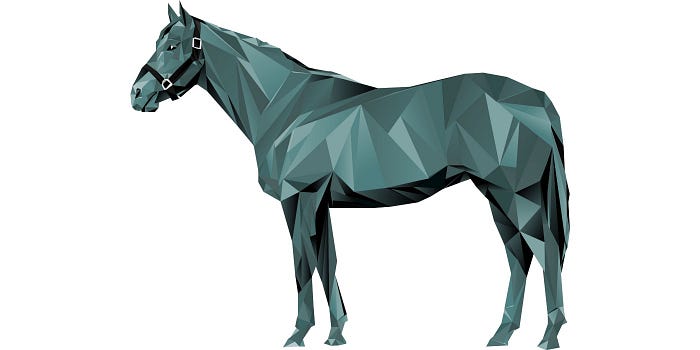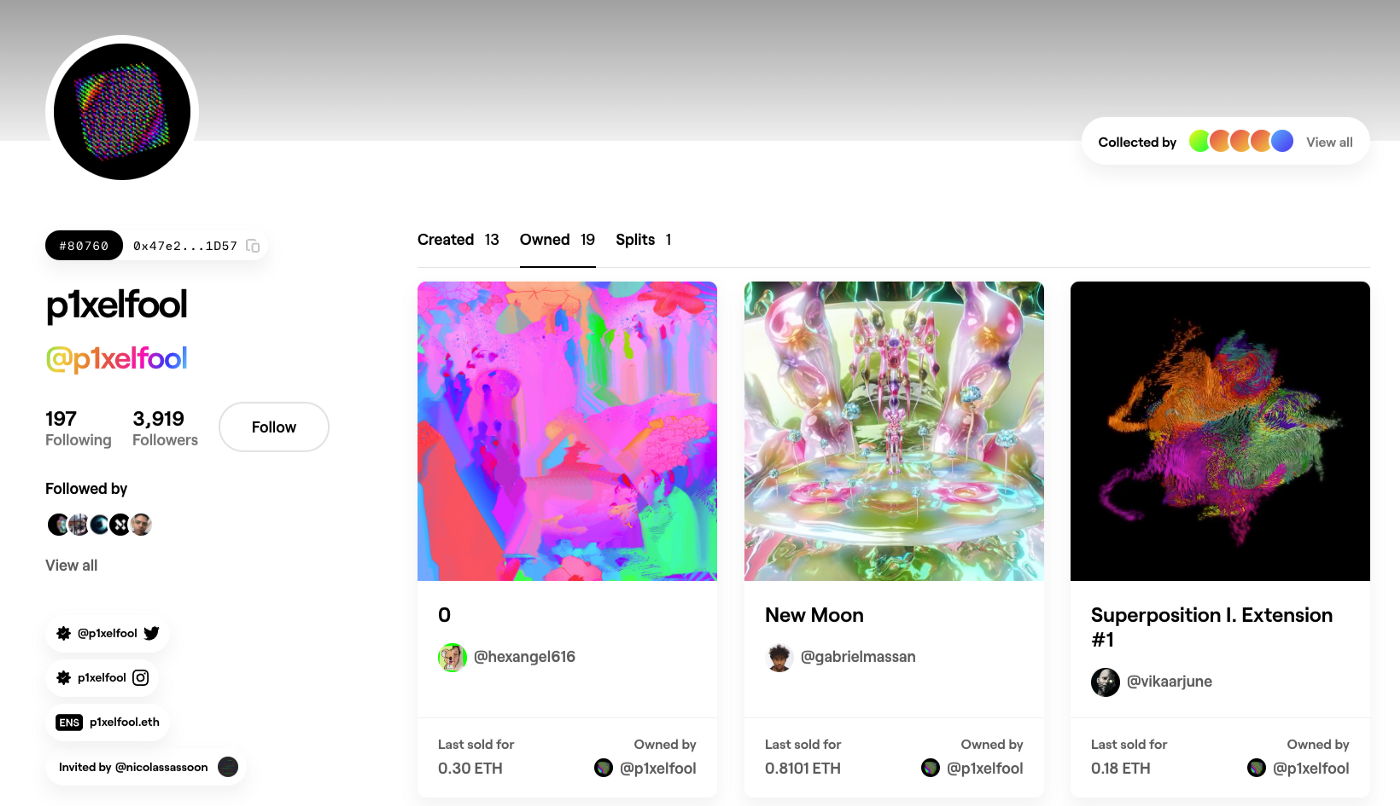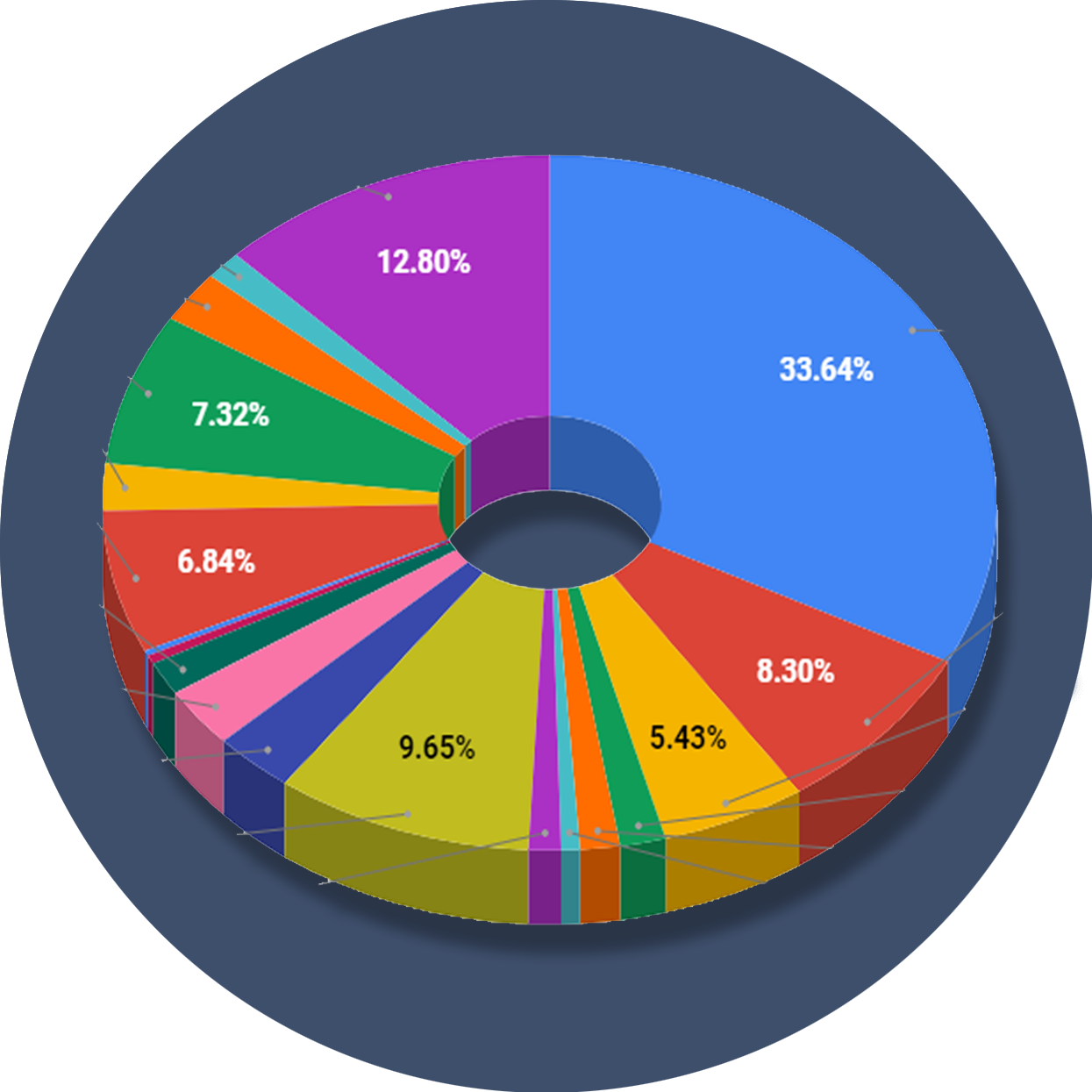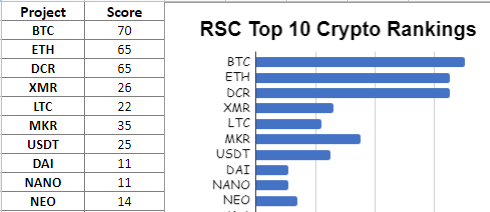
Checkmate's Corner (Doc Is Off Today)

Mind Of Mav
Investing In NFTs: How To Actually Buy & Sell Them
If you’ve made it this far, let’s dive into what you’ve really been waiting for — how to actually get started buying NFTs. First, let’s start with where exactly you should be getting your NFTs.
So which blockchain should I be buying NFTs on?
As mentioned prior, there are many different blockchains on which NFTs presently proliferate, from Ethereum to Solana to Tezos and Algorand and more, with the vast majority of the NFT activity happening on Ethereum. That said, a growing number of NFT projects are choosing to take place on Solana and other blockchains due to the high gas fees incumbent with Ethereum at present.
I am personally quite skeptical that Solana will actually outpace Ethereum as just about the only argument anyone gives for choosing to use Solana or Tezos or anything else over Ethereum is that it’s cheaper and faster to use these other blockchains, in no small part precisely because Ethereum is so dominant in its use that the congestion on the network causes fees to spike higher than on competing blockchains.
This is one of those things that is a really easy superficial refrain that has strong meme power that allows it to spread quite effectively, as anyone can grasp the inherent value in “cheaper and faster” in about three seconds, and it intuitively sounds obviously better. Everything in the world of ‘decentralized’ blockchains comes at a cost, however, and the technical tradeoffs Solana has made to achieve “cheaper and faster” deserve careful examination.
Moreover, with the advent of Ethereum 2.0 with Proof of Stake and sharding, along with the Layer 2 solutions already active on top of Ethereum like Polygon and Immutable X, fees on Ethereum are already negligible or even free (the NFT I’ll be sending all of you/allowing you to mint, for example, will be built on top of an Ethereum Layer 2 solution that has negligible fees — Polygon). Couple this with the fact that Ethereum has more developers and users than every other blockchain combined, and my personal opinion is that the network effect moat of Ethereum is fairly unassailable.
In short, unless another competing blockchain is somehow able to overtake Ethereum by sometime early to mid next year, when Ethereum 2.0 Proof of Stake with sharding goes live and Layer 2 protocols mature and cause the cheaper and faster argument to be moot because Ethereum will also be cheaper and faster, I don’t really see how any competing blockchain provides any inherent advantages so great as to unseat Ethereum as the dominant and eventually only smart contract blockchain.
To overtake Ethereum, a competing blockchain would need to beat it in both number of developers and users, and in terms of ease of development with sufficient infrastructure and developer tooling built up to make developing on those competing blockchains as easy and as supported as is developing on Ethereum right now, and on a number of other fronts as well. Because of profound network effects, I don’t really see that happening — but I could always be wrong, so obviously do your own research and don’t just take my word for it (after all, Facebook did kill Myspace, so it’s not strictly impossible).
There is, after all, a reason why we only have a single set of Internet protocols we use so that all websites can be interoperable with one another, and people don’t have to install several apps just to be able to interact with the same kind of content across several different kinds of internet protocols (remember ALOHAnet, for example? Yeah, neither do I, for a reason, because all we need is the internet). Tl;dr, I see the base layer blockchain competition as a winner take all battle. No competing blockchain right now promises any additional functionality that Ethereum can’t already do with its smart contract system, as it’s already Turing complete, and rival blockchains only attempt to compete on speed and cost, and as those alternatives all come with tradeoffs in terms of centralization and more and as Ethereum will solve these problems and already is solving them with PoS, sharding, and L2 solutions, I don’t really see how someone beats Ethereum at the base layer blockchain level.

All of that said, I’ll be focusing the remainder of this newsletter on discussing how to interact with NFTs on the Ethereum blockchain.
Getting started with Ethereum and MetaMask
So you want to buy your first NFT! Excellent. The first thing you’ll need to do is buy some Ethereum, which will be the native currency you’ll predominantly be using to buy and sell NFTs.
To do so, you can sign up for a number of different cryptocurrency exchanges, such as Coinbase, the most legitimate and trusted exchange if you happen to be in the US or parts of Europe, or Voyager, or Gemini, or FTX, or Crypto.com, or if you really have to, Binance.
This part isn’t the most important thing in the world, because you generally shouldn’t be holding your crypto on an exchange for the greatest amount of security. In an ideal world, you’ll just be buying there and then transferring funds immediately to a hardware wallet, and so your risk of losing all your money because you picked the wrong exchange to buy crypto on is minimal.
Alright, so now that you have some Ethereum, we’re ready for our next step. The next step differs depending on how secure and how correctly you’d like to do things. As with many things in crypto, there’s an easy way and then there’s a hard way, and the easy way leads to oftentimes faster starts and greater immediate profit, but ends similarly much more often with heartbreak and complete catastrophe.
The easy way is just to go to MetaMask.io, download the Chrome extension, and set it up, remembering very importantly as you do so to keep a hard copy of your seed phrase in a very secure place where no one else will ever find it but also you will never lose it (like a safe or a safe deposit box).
This is critical, because if anyone ever gets access to your seed phrase or private key (the NFT world is rife and rabid with scams right now, to put it as the understatement of the century, and literally everyone will eventually try to ask for your seed phrase — never, ever give it to anyone, under any circumstances. Not even your mother, because it’s probably someone impersonating your mother) they get access to all your funds and all your NFTs and you will lose everything, but at the same time, if you lose your seed phrase or private key (same thing in essence — the seed phrase is a mnemonic used to derive your private key, which is the real thing that’s needed to access all the funds and NFTs associated with your public key — more on this in Crypto 101), you lose access to all your funds and NFTs forever.
Then, all you have to do is copy the public address shown in MetaMask, and send all your Ethereum you just bought from Coinbase or whatever other exchange you used to that address, and boom, you can go buy NFTs right away.
Please don’t actually just do this
All nice and simple, but this comes with unimaginable levels of risk in the present NFT ecosystem. I am not shitting you in the slightest when I tell you you’ll get at least 10 people trying to scam you every single day, with Discord DMs, or random spam airdropped into your OpenSea wallet, or emails, or texts, or any of about a million other different very creative and very malicious scam techniques.
Oftentimes, scammers will send you links (tl;dr, literally never, ever click a link someone you don’t know sends you — and even if you think you know them, odds are it’s actually someone impersonating someone you know, like a Discord user who changes their profile picture and name to look identical to a Discord server you’re actually in or a real person you’re actually talking to) that go to phishing sites, with things like Opensea dot fo instead of Opensea dot io (a real phishing scam I got), or world-of-women dot art instead of worldofwomen dot art (another scam that got a lot of people recently), and on those sites, which will look identical to the real sites, it’ll ask you to connect your MetaMask wallet, and then will prompt you to do some too good to be true transactions, which you might approve in a rush to get rich quick, after which you’ll realize you’ve literally lost everything.
Or they’ll ask to screen share with you and masquerade as support, and sneak a peek at your seed phrase or private key and then boom, you’ve lost everything as well.
Or they’ll just infect your computer and steal all your money that way. There’s a common understanding in security circles that anything connected to the internet should be considered compromised, and this applies doubly so to anything involving crypto, where once you are compromised and all your assets are stolen, there is generally no recourse, unlike with most things in the world. Being your own bank is a double edged sword in that regard — you don’t have to trust anyone else, but you also have to trust yourself more than ever before.
A wallet connected directly to and exposed to the internet, like a native Metamask wallet, is considered a hot wallet in contrast to a cold wallet, which is a wallet that is never exposed directly to the internet. A hot wallet should be considered inherently vulnerable and compromised, and you should generally never store anything on a hot wallet for any meaningful period of time, and use it, if you have to use it at all, merely for transitory transactions like immediately buying something quickly and then transferring it to your cold wallet for storage.
Long story short — if you decide to just rely on a MetaMask Chrome extension native wallet to store all your NFTs, expect to eventually lose all of them in a hack. All you need to do is screw up once, ever, to lose everything, and even the most sophisticated of investors and the most tech-savvy people in this space have been privy to being hacked.
Case in point, here’s a founder of a literal smart contract insurance company, Nexus Mutual, on how he got hacked for over $8 million because someone installed a malicious version of the MetaMask Chrome extension on his computer that replaced and yet was identical in every way to the real one and thereby managed to trick him into approving sending a massive amount of crypto to the hacker’s address despite using a hardware wallet. Knowing that even with a hardware wallet, which is infinitely more secure than a Metamask native hot wallet, the literal founder of a crypto company still got hacked, do you really want to take your chances with playing it fast and loose in this space?
Okay, so with that frankly very insufficient several paragraph long caveat out of the way, let’s speak to the hard way of getting ready to become a more secure NFT pro. Long story short, what you need is a hardware wallet, which acts as essentially a cold wallet that can be fairly easily used still practically as a hot wallet can to easily transact. How a hardware wallet does this is by physically being a new hardware device where the private keys to your wallet are kept and never, ever exposed to the internet or your computer under any circumstances (or so we hope, though in reality these things are quite difficult to actually verify), and instead only sends transaction signatures over to your computer in order to actually execute transactions.
With this in mind, your two primary options for a hardware wallet at this point in time are either a Ledger (the most popular) or a Trezor (the most OG and the one I personally use because I like to be cool/I was too early to get a Ledger since it didn’t have hidden wallets with passphrases back then), as those are the two principal hardware wallets that function well with MetaMask at present time. A Ledger is probably the best bet.
Once you acquire your hardware wallet, you’ll follow approximately the same steps as above to get it fully setup. You’ll want to securely store your seed phrase just as with the Metamask wallet setup and make sure no one else can ever access it but also that you’ll never lose it, and whatnot.
Finally, go ahead and connect your Ledger or your Trezor to MetaMask, and then proceed to use MetaMask just as you might with a direct native hot wallet. The only difference now is every time you do a transaction, MetaMask will prompt for you to confirm that transaction on your Ledger or Trezor, which adds a crucial extra layer of strong security to each transaction. Be sure you actually do read each transaction that MetaMask asks you to confirm, as well, and make sure the inputs and outputs shown on your Ledger/Trezor are as you expect — not checking exactly what the Ledger or Trezor is asking you to confirm is precisely how the Nexus Mutual founder got hacked and lost $8 million despite using a Ledger, and also how the other guy who lost all his assets in an OpenSea Discord support scam got screwed over.
Sweet. Now that you have your battle armor fully equipped over your previously naked wallet, let’s dive into how to actually create and sell your own NFTs, and then how to actually buy NFTs, and where.
Minting (creating) and selling your own NFTs
If you’d like to create your own NFTs, you’re in luck! The process is more simple than ever before, and plenty of applications have been setup to walk you through the process in as simple and effortless a manner as possible.
Showtime is one of the easiest and best made sites that help you mint your own NFTs on the Ethereum blockchain completely for free via the Layer 2 solution Polygon. Just click the Create button on Showtime and it will walk you through the process in a flash as soon as you connect your wallet. Here, you can set the number of editions you’d like to mint for your piece, as well as the royalties you’d like to earn every time the piece is resold in a secondary sale.
Note that Showtime doesn’t yet have functionality to allow you to sell your NFT directly on the site yet, but once you mint the NFT, you can list it for sale anywhere else, such as on OpenSea, which is the primary marketplace where NFTs are bought and sold at present.
Similarly, you can create NFTs directly on OpenSea, also for free using Polygon if desired, by clicking the Create button over there. The same goes for other completely open to all sites, such as Rarible and MakersPlace.
If you’d like to fetch higher prices for your work, the next step up the ladder is an invitation-only platform known as Foundation. You’ll need to be invited to this platform by an artist that’s already successfully sold at least one work (every artist gets 3 invites to give out after selling their first piece of art on Foundation), so it’s a little more curated and a little harder to get on, but the prices you can sell your pieces for here are generally a little higher than on the completely free-for-all NFT platforms.
Note that you’ll also need to pay a fair bit in gas fees to mint your artwork here directly on the Ethereum blockchain itself, so this is a little more costly than starting on the other platforms. Please look into this step more, and how to minimize your fees, because almost every artist I’ve met pays 2–3x more than they really need to to mint and list their NFTs, and it pains me to my cheap core.
Finally, if you’re ready to hit the big leagues, you’ll want to apply to SuperRare, NiftyGateway, and/or KnownOrigin, which are three highly curated platforms that only accept artists they carefully choose through an application process. Here’s NiftyGateway’s application page, and here’s SuperRare’s. KnownOrigin, unfortunately, is presently closed to applications at the moment.
It’s not easy to break into selling NFTs as a new artist, but it is far easier and more lucrative than trying to break into the traditional art market by far, as there still is comparatively far less competition in the NFT ecosystem for artists, and you also have direct access to a global audience of buyers with a lot of money. Most NFT collectors spend their time on Twitter these days, so one of the best ways to start breaking into the community is to start cultivating a strong following on Twitter of people plugged into the NFT community. Easier said than done, but also definitely something many have done successfully, so don’t be discouraged, and give it a shot!
What NFTs should I buy and why and where
Okay, now on to buying NFTs. There are roughly two classes of NFT buyers right now, and it is my opinion you probably want to belong to one of these more than the other, but ultimately I could be totally wrong, because there are many people becoming butt rich in both camps.
The first class of NFT buyers are hardcore flippers, who find the most promising and most hyped projects that everyone else is likely to buy into, and then use bots and scripts and ninja reflexes to mint those projects before everyone else, and then quickly flip them.
Flippers also use pro tools like Nansen.ai and icy.tools and RaritySniffer and rarity.tools and rarity.guide and about a million other things to carefully track data and analytics about what projects are taking off as soon as they take off, and identify the best NFTs to purchase on the secondary market even after initial minting so as to be able to flip these for a massive profit as the project continues to rise in stature. They also use primarily Twitter and Discord to follow influencers in the space and identify up and coming new promising projects before they launch (as MEVCollector suggested in the Twitter thread above, Pixel Vault and Metaverse HQ are fairly well established communities in the space, along with Friends with Benefits and many others). NFTCal is also a very useful calendar of all upcoming major NFT drops, so you can keep abreast of all notable projects and forego missing drops because of information slipping through your limited time.
Granted, long term investors also use these tools to gain similar insight into projects that have real long term communities growing behind them and identify the best NFTs in those projects to buy into now, and I’ve personally paid $700 for a lifetime icy.tools premium membership and pay an ongoing hefty monthly sum for access to Nansen.ai
The second class of NFT buyers are those who are looking to identify the most promising NFTs around today that may have long term value, and looking to buy into these and hold them for multi-year time horizons at a minimum. Projects that meet this criteria are far fewer than projects that meet a criteria for flipping, as the greater fool theory and the proliferation of flippers in the market right now provides much opportunity for taking the money of the other speculators swarming all around you before the tide washes out.
What kinds of projects might stand the test of time? First and foremost, projects that have incredibly strong, resilient communities behind them that grow in organic ways and stick around for much more than just the money — the precise paradox of things is that the communities that form not for the money (or at least not solely for the money) but for other reasons are precisely those that are likely to be worth the most money in the end, just like CryptoPunks, because they’ll weather the inevitable downturns of the mercurial and capricious crypto and NFT markets far better than other projects.
A project where everyone is in it just for the money will grow tremendously faster than other projects when the price is going up, as the price itself increasing is the primary draw which brings all the fish in the speculator swarm to feast. At the same time, as soon as the price begins to falter, as it inevitably will at some point, all the speculators will rush to the exits to not be the last fool standing holding all the bags, as there’s nothing else keeping them around besides the price, and thus when the price goes away, so too much all the speculators, in the most rapid and least orderly fashion possible.
A project where everyone isn’t in it for just the money, but rather is in it for the community and whatever the community is building, is one where even when the bottom falls out in the market and the price craters, members will refuse to sell, and will in fact continue to grow and build on the project, such that when the tide flows back in and prices and demand begin to rise again, the project will be leaps and bounds ahead of all the other projects that were skinned to their bones and left as skeletons without a community when the tide last washed out. When that happens, the most obvious project for everyone to rally behind will be the project that kept growing even when there was no financial incentive behind it — and no other project will really stand a chance of catching up, having abandoned the ecosystem in the downturn.

So yeah — identifying the projects that will stand the test of time is incredibly difficult to do in a bubbly bull market with so much hype, because oftentimes the best projects with long term horizons and invested communities can look quite similar to the projects with teams that are just in it for a quick money grab and communities that are here for the same. You really need to dig deep and spend time in each community to suss out the differences, and that’s not something you can do at a quick glance — it takes time and investment.
In short, the best way to determine what things are likely here to stay is to see how you yourself feel about them — if you find a community you love and a project you want to invest in for more than just the promise of quick riches, and you have confidence that even if the price of your asset falls 90% or more, you yourself won’t sell, and you see that others feel the same way…well, then that’s a pretty damn good sign.
And therein lies the paradox and the true power of NFTs. Just about everyone right now is coming in for the money, just as almost everyone who got into crypto initially became interested because of the meteoric rise in price, but that’s just the Trojan Horse, really, to trick you into inviting NFTs into your heart.

Once you truly become invested in an NFT project and community you love, you’ll start to see that NFTs are about so much more than just the money, and you’ll stay even when the inevitable bear market for NFTs comes, and you’ll keep building and investing in the community and growing the NFT ecosystem, and it is precisely for that reason that you will be, in perhaps ~four years from now, if all goes well, just like those early true believers in CryptoPunks in 2017, who came for the hype and stayed for the heart, and weathered an entire four years of worthlessness and stagnation in price and interest from the external world to all become untold filthy rich millionaires today.
Remember — art, and many of the other best kinds of assets, like collectibles and antiques, derive much of their value from their emotional stickiness. If you’re going to feel emotionally bad selling your dog, even if someone offers way more than going market value for dogs for your dog, like $30,000 for Sparky, you’re probably not going to sell Sparky. Conversely, if you bought Sparky on an impulse for way more than Sparky was worth and now Sparkies are worth only one tenth of what you paid for your non-fungible one and only Sparky, you’re probably not going to regret it and kick yourself in the butt for buying your Sparky and sell him off to an impartial collector for a 90% loss.
Same thing with a piece of art, and any other kind of NFT. If you’re going to feel sad selling it, even for a huge gain — chances are others are going to feel the same way, and thus fewer of that asset will ever go on sale on the market, and as we all know — the intersection of supply and demand is what determines price. If emotional stickiness causes buyers of certain NFTs to want to never sell them for any price, or at least anything short of a life changing price, then there will be far fewer of those NFTs on the market, and buyers will need to pay much dearer prices to acquire those NFTs. Eventually, as all NFTs of a limited scarce collection that can command that degree of emotional stickiness are quietly siphoned away by ever richer people who have no need to ever sell them at any price, the supply will shrink ever yet further until it may practically be non-existent, at which point the price may commensurately also reach a point of similar ludicrosity in the opposite direction, approaching the limit of effective infinity.
What kinds of projects might achieve this kind of community growth and emotional stickiness? Typically projects that are either the most OG in their specific domain, like CryptoPunks for PFP NFT projects, or Art Blocks for generative art pieces (two of the best pieces I’ve read in the NFT space that personally convinced me on Art Blocks), and/or the most novel in their execution with the most potential for derivatives to follow in their wake, like the Loot Project, (following Dylan Field’s brilliant meme chain rule), or projects with the potential for the most ongoing interaction and scalable communities centered around a central premise such as a game, such as Guild of Guardians (made by the same people who made the OG blockchain trading card game, Gods Unchained, as well as one of the major NFT L2 platforms, Immutable X).
1/1 limited edition art pieces also fall into this category, but are far more risky, and approximately equivalent to investing in art in the real world. Think of this as akin to angel investing, essentially — if you have incredibly good taste and judgment and believe you can identify the artists who will capture the new zeitgeist of this NFT and crypto and metaverse era better than the rest and rise above the crowd to great fame and future success, you can certainly make tremendous amounts of money seeking out the right artists and collecting their pieces before everyone else.
If you can’t, chances are you’ll be stuck holding art pieces that never really grow in value, and likely in fact fall against the currency you bought them in (ETH). Still — I’ve found that investing in 1/1 art is by far the most emotionally meaningful endeavor someone can engage in in the NFT space, and the amounts artists are making here are literally life changing, so many times I invest in 1/1 art just to buy pieces that I love that I wouldn’t sell even if they went up 10x and I wouldn’t care even if they went down 10x, and to support artists that are deeply incredible, amazing people and help encourage them to continue making their incredible art and meaningfully bolster them in a financial way towards that end.
The best places to go about finding these 1/1 or otherwise limited edition art pieces are on platforms like SuperRare, KnownOrigin, and Foundation (be careful with the last one — it’s not as carefully curated as the first two, and scams have been known to be found there). There exist less curated platforms such as Showtime, Rarible, MakersPlace, and even OpenSea (where most of all secondary sale trading activity occurs) directly, but with these, you need to tread with extreme caution so as to not fall for scams, though you can definitely also find diamonds in the rough here.
Protip: One strategy you can use to find and buy what the real tastemakers are buying is to follow their accounts on these various platforms. Because the blockchain is totally transparent for everyone to see, you can see literally everything that everyone is buying, and that includes what the artists themselves who are super successful are buying (buying an already successful artist is approximately akin to say, buying a stock after it IPOs, perhaps, whereas buying an artist that has incredibly strong potential but hasn’t yet made it is akin to angel investing, with commensurately infinitely high risk and reward profiles).

Those are, of course, mere starting points, and in fact not even projects that I am even specifically suggesting you invest in, as I very, very strongly do not want to take the responsibility of suggesting anything for anyone to invest in in this space. The NFT space is even earlier right now than 2017 was for crypto, and with the field being so nascent, while I feel incredibly confident in saying that NFTs will change the world as we know it profoundly and permanently, as I might have said about the internet in 1999, I don’t feel remotely as confident in proclaiming that any specific NFT project is going to stand the test of time right now and make it to that end world state. Be wary of anyone who does proclaim these things, and make sure you assess their claims from first principles, extricated from all the hype.

The ReadySetCrypto "Three Token Pillars" Community Portfolio (V3)
Add your vote to the V3 Portfolio (Phase 3) by clicking here.
View V3 Portfolio (Phase 2) by clicking here.
View V3 Portfolio (Phase 1) by clicking here.
Read the V3 Portfolio guide by clicking here.
What is the goal of this portfolio?
The “Three Token Pillars” portfolio is democratically proportioned between the Three Pillars of the Token Economy & Interchain:
CryptoCurreny – Security Tokens (STO) – Decentralized Finance (DeFi)
With this portfolio, we will identify and take advantage of the opportunities within the Three
Pillars of ReadySetCrypto. We aim to Capitalise on the collective knowledge and experience of the RSC
community & build model portfolios containing the premier companies and projects
in the industry and manage risk allocation suitable for as many people as
possible.
The Second Phase of the RSC Community Portfolio V3 was to give us a general idea of the weightings people desire in each of the three pillars and also member’s risk tolerance. The Third Phase of the RSC Community Portfolio V3 has us closing in on a finalized portfolio allocation before we consolidated onto the highest quality projects.
Our Current Allocation As Of Phase Three:

Move Your Mouse Over Charts Below For More Information

The ReadySetCrypto "Top Ten Crypto" Community Portfolio (V4)
Add your vote to the V4 Portfolio by clicking here.
Read about building Crypto Portfolio Diversity by clicking here.
What is the goal of this portfolio?
Current Top 10 Rankings:

Move Your Mouse Over Charts Below For More Information

Our Discord
Join Our Crypto Trader & Investor Chatrooms by clicking here!
Please DM us with your email address if you are a full OMNIA member and want to be given full Discord privileges.
